 Marine Nationale (1887-80), Protected cruiser, 1890-1910
Marine Nationale (1887-80), Protected cruiser, 1890-1910WW1 French Cruisers
Sfax | Tage | Amiral Cecille | D'Iberville class | Dunois class | Foudre | Davout | Suchet | Forbin class | Troude class | Alger class | Friant class | Linois class | Descartes class | D'Assas class | D’Entrecasteaux | Protet class | Guichen | Chateaurenault | Chateaurenault | D'Estrées class | Jurien de la Graviere | Lamotte-Picquet classDupuy de Lome | Amiral Charner class | Pothuau | Jeanne d'Arc | Gueydon class | Dupleix class | Gloire class | Gambetta class | Jules Michelet | Ernest Renan | Edgar Quinet class
Suchet was a protected cruiser ordered under Admiral Théophile Aube of jeune ecole fame, Minister of Marine at the time. He favoured a cruisers-first fleet and defensive array of torpedo boats. As for cruisers, they needed to be of various types and Suchet repeated the same recipes as Davout. Both were ordered as medium cruisers. Initially from the same class, Davout’s construction issues forced design changes to Suchet ended as her own class. Suchet was slightly larger and added 100 mm guns to her main 164 mm (6.5 in) armament. She was also a bit more powerful.
Suchet served in the Mediterranean Squadron until 1897, then Levant Division, eastern Mediterranean. In 1900 this was the Naval Division Atlantic. In 1901 she brought relief after the eruption of Mount Pelée in the Carribean, evacuating around 1,200 people to Fort-de-France. She also was present in a minor diplomatic incident with Venezuela. In 1902, she was reserve until struck in 1906 and sold for BU.
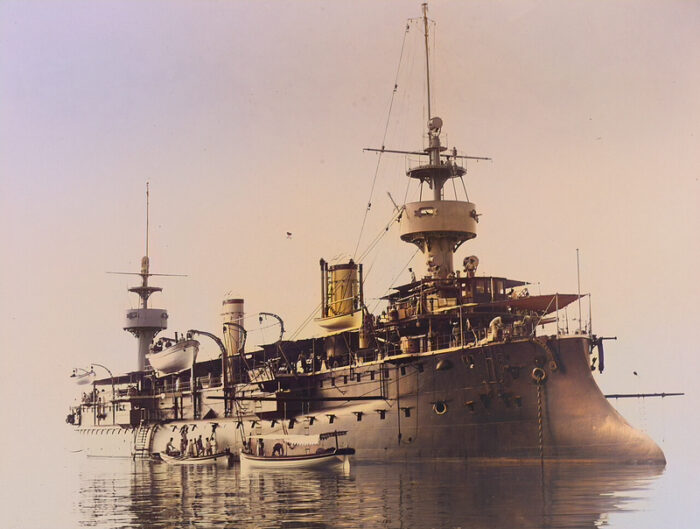
Design of the class
Design Development
The concept underlaying the construction of Suchet were the same as her near-sister Davout. She was to be a completely different protected cruiser from the previous Sfax, Tage and admiral cecille, all large, slow masted cruisers better tailored for overseas stations. Indeed, both were designed during the tenure of Admiral Théophile Aube as French Minister of Marine in 1886, albeit first design specifications came from his predecessor Charles-Eugène Galiber by December 1885. Galiber wanted faster, smaller 2,600 t cruisers capable of 18 knots with forced draft. Aube arrived at the office in January 1886 and for his cherished doctrine envisioned new types of cruisers combined with torpedo boats both for protection at home, and attack enemy merchant shipping abroad.
His proposed budget called for six large cruisers and ten smaller cruisers, with no less than 11 designs evaluated by the “Conseil des Travaux” under chief engineer De Bussy. They all agreed tese cruisers needed to be fast, at least 20 knots (37 km/h; 23 mph). Aube ordered three “medium cruisers” as the plan already included three of his six large protected cruisers, on 1 March 1887: They were the Davout, Suchet, and Chanzy. Contracts were only finalized under his successor, Édouard Barbey.
The latter was less enthused on the ideas of the Jeune Ecole and wanted to reduce the program. In May 1887, the new budget approved three new large cruisers as intended, which became the Alger class and if the ten “small cruiser”, it was reduced to six: The Forbin and Troude classes plus two “medium” cruiser. Chanzy was cancelled, Davout and Suchet became the medium cruisers, prototypes for the later Friant class. But alteration on Suchet by the supervisor at Toulon meant only Davout was completed to the original design. But in the end, neither Davout and Suchet met their intended speed, or just barely, leading to further modifications for the Friant class cruisers, the next “mediums” in the tree.
Suchet’s specific changes
Suchet was built at Las Seyne, near Toulon arsenal and shipyard, unlike Davout, also built at Toulon, but earlier. She was laid down on 12 September 1887. Suchet was laid down a bit later on 1st October. But during construction, shortcoming were detected early on as construction of Suchet progressed, the local shipyard supervisor, Delphin Albert Lhomme, requested, and obtained changes to the design. The first was to ask the addition of a torpedo tube to the bow, which was lacking in the original design. It seems it was pushed by influential partisans of the Jeune Ecole, which insisted about placing torpedo tubes on any Marine Nationale platform.
This was approved on 28 March 1887. As work continued, the supervisor was adamant that the original plans led to a cramped engine room with insufficient ventilation and not suited for easy maintenance. He stopped construction at this stage on 20 March 1888 to allow planned alterations and completely reworked the internal layout of the machinery system, basically straight after the base of the hull was constructed, with the double hull and reinforced plating to support the heavy cast boilers and VTE engines.
Lhomme completed the new design in 1890. He submitted it to the navy minister Barbey on 16 August. The hull notably was stretched up by no less than seven meters (23 ft) and additional space then could be used to enlarge the engine room by 2.16 m (7 ft 1 in), and the remainder used to fit a fourth boiler room large enough for two more fire-tube boilers side by side. On 13 September, Barbey approved this, so work resumed at the yard four days later. Superstructure was also redesigned, the forecastle was extended by 1.2 m (3 ft 11 in) and other changes were made during later construction.
In between, Davout had been launched on 31 October 1889 and completed on 20 October 1890. She showed her heavy military masts was a real issue for stability. So Suchet’s masts were shortened (but not yet replaced by pole masts as it would be anathema for many in the Navy yet). This allowed to reduce top weight, but further delayed launch. Also, it was decided Davout’s four 65 mm (2.6 in) anti-torpedo boat guns were too weak, and they were replaced by brand new 100 mm (3.9 in) guns on Suchet. On 28 January 1893, as she was still not close to launch (pushed back to August) a new quick-firing version of the 164.7 mm (6.48 in) for the main battery replaced the original ones. They were also countless minor alterations. After being launched on 10 August 1893, Suchet was completed on 1 January 1894, four years after her sister. In between, the Friant class was started in 1891, but they ended slower than anticipated at 18.5 knots, despite all what was learned from both cruisers.
About the name:
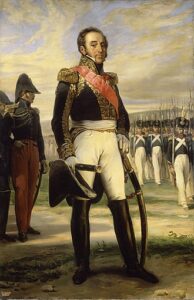 Suchet was named after Louis-Gabriel Suchet (1770-1826) Napoleonic Marshall, 1st duke of Albufera. Born in Lyon, central southern France, her became a prominent French military commander during the Napoleonic Wars, known for his exceptional leadership and administrative skills, especially during the Peninsular War in Spain. He rose from modest origins to become one of Napoleon Bonaparte’s most capable marshals. He started as a volunteer in 1792 during the French Revolutionary Wars and quickly rose through the ranks due to his talent and bravery. In the iconic Italian Campaigns she served under Masséna and Bonaparte, played a crucial role at the Battle of Austerlitz (1805), gaining further recognition. In the peninsular War he was appointed commander of French forces in Aragon, Spain in 1809. Known for discipline, effective administration, and relative leniency toward civilians, which contrasted with other French commanders in Spain, her was called by the Spaniards « El Hombre justo ». He captured Lérida, Mequinenza, and Tarragona but kept his troops in check, so no exactions were made on the population. His successful pacification and governance of Aragon won him praise among the population and solidified his reputation. He was awarded in recognition the title of Marshall in 1844 and Duke of Albufera in 1812 after capturing Valencia. Suchet supported the emperor during the Hundred Days but later reconciled with the restored Bourbon monarchy.
Suchet was named after Louis-Gabriel Suchet (1770-1826) Napoleonic Marshall, 1st duke of Albufera. Born in Lyon, central southern France, her became a prominent French military commander during the Napoleonic Wars, known for his exceptional leadership and administrative skills, especially during the Peninsular War in Spain. He rose from modest origins to become one of Napoleon Bonaparte’s most capable marshals. He started as a volunteer in 1792 during the French Revolutionary Wars and quickly rose through the ranks due to his talent and bravery. In the iconic Italian Campaigns she served under Masséna and Bonaparte, played a crucial role at the Battle of Austerlitz (1805), gaining further recognition. In the peninsular War he was appointed commander of French forces in Aragon, Spain in 1809. Known for discipline, effective administration, and relative leniency toward civilians, which contrasted with other French commanders in Spain, her was called by the Spaniards « El Hombre justo ». He captured Lérida, Mequinenza, and Tarragona but kept his troops in check, so no exactions were made on the population. His successful pacification and governance of Aragon won him praise among the population and solidified his reputation. He was awarded in recognition the title of Marshall in 1844 and Duke of Albufera in 1812 after capturing Valencia. Suchet supported the emperor during the Hundred Days but later reconciled with the restored Bourbon monarchy.
Hull and general design
Suchet ended longer than Davout at 95 m (311 ft 8 in) long between perpendiculars, 97.7 m (320 ft 6 in) at the waterline, 98.95 m (324 ft 8 in) long overall. Versus 91.25 m (299 ft 5 in) overall for Davout. She was also beamier for stability at 12.12 m (39 ft 9 in) versus 11.62 m (38 ft 1 in) and with a greater average draft of 5.35 m (18 ft), up to 5.9 m (19 ft 4 in) aft, versus 4.65 m (15 ft 3 in) for Davout. This traduced into a large designed displacement of 3,440 t (3,390 long tons; 3,790 short tons) versus 3,330 t (3,280 long tons; 3,670 short tons) so an increase of “only” 110t. Not a heavy price to pay for her many extensions.
Her hull shape was about the same however, typical of the time, with a pronounced ram bow, overhanging stern, flush deck and tumbehome. However, the latter started in a more abrupt way than her sister, stopping at the battery deck, which had flat sides, also creating cutouts for the amidship guns to fire in the axis. The bow was seemingly slightly reinforced to be actually used for ramming attacks, and acted as reinforcements for the bow torpedo tube, housed by the tip of it. The superstructures were kept minimal to avoid top weight issues, with a small conning tower forward only, a light wooden bridge above and behind, and tow shorter heavy military masts with fighting tops for her lighter guns and a second top for observation and small platform above supporting searchlights. Her crew amounted to 335 officers and ratings, more than near near-sister (329). She also had a fleet of small boats of all types and descriptions for daily service from coal barges to fast dispatch cutters.
Powerplant
Such had two horizontal triple-expansion steam engines like Davout driving each a 4-bladed bronze fixed pitch screw propeller. Steam was built up in twenty-four coal-fired fire-tube Belleville boilers (versus eight for Davout). They were smaller and lighter, and ducted into two widely spaced funnels amidships, a large fore funnel and a thinner aft one. This powerplant was rated as designed, to produce 9,500 indicated horsepower (7,100 kW) for a contracted top speed of 20 knots. To compare, this was only 500 hp more than on Davout, and with the dimensions and displacement increase, the speed gan was negligible and proved a disappointment.
Indeed, speed tests of 1894, at forced draft produced 9,504 ihp (7,087 kW) but the measured speed was only of 20.41 knots (37.80 km/h; 23.49 mph) versus 20.7 knots (38.3 km/h; 23.8 mph). So for all Davout’s critics about the lack of power, she was lighter and ended faster than her sister, albeit for a very thin margin and not sustainable in service anyway. The French engineers will struggle with small hulls for the next cruisers (notably due to insufficient facilities) and it proved hard to pass 20 knots on any French cruisers at the time.
Coal storage for Suchet amounted to 529 t (521 long tons; 583 short tons) at normal load but up to 663 t (653 long tons; 731 short tons), versus 477t/534 t on Davout. Some sources even states 836 tonnes. This made for a range of 4000 nautical miles at 10 knots estimated. But like Davout, her propulsion system proved unreliable in service, and it was difficult to clean either the boilers or their uptakes whole under steam. With the bad quality of coal used at that time, speed soon fell down after a few day’s operation. They were not suited for overseas operations or any long-distance cruises. The average speed in service ended at 13-14 knots (24 or 26 km/h; 15 or 16 mph). The crew alternated cleaning boilers and uptakes, so none were lit up at the same time. Tese frequent cycles also added to the stress of the boilers and other parts, and added to the misery.
Protection
No significant change was made on Suchet compared to Davout in that matter, in short:
The armoured deck ranged from 30 to 82 mm (1.2 to 3.2 in), with the thickest part on the slopes.
The Conning tower had walls 40 mm (1.6 in) thick
The Gun shields were 54 mm (2.1 in) thick.
This protection was in mild steel. Amidships, the deck slopes reached 82 mm (3.2 in) thick for the flat portion, covering the propulsion machinery spaces and magazines. Forward and aft it was tapered down to 30 mm (1.2 in). Toward both sides it sloped down, at 80 mm (3.1 in) thick. The deck was in addition layered on 20 mm (0.79 in) hull plating. The machinery spaces had a second layer against shell splinters as well. Above the armour deck there was the usual subdivided cellular layer, 460 mm (18 in) to contain flooding. The gun shields, 54 mm (2.1 in) mostly protected the crew from shell fragments.
Armament
It was basically the same as her sister and Amiral Cecille, Six 165mm/30 M1884 at first (but of a new faster-firing model). The complement was modified heavily with four 100 mm (3.9 in) guns instead of 65 mm, eight 47 mm (1.9 in) Hotchkiss guns and eight 37 mm (1.5 in) guns instead of four 47 mm (1.9 in) and two 37 mm (1.5 in) guns, so quite a massive increase for anti-torpedo defence, plus a supplementary 356 mm (14 in) torpedo tube at the bow, for seven total.
Main battery:
Suchet’s initially planned six 164.7 mm (6.48 in) M1881 28-caliber on single pivot mounts were all replaced by the same guns, but with modified breeches in order to fire faster.
Four of the guns were mounted in sponsons on the upper deck, two on each broadside, like for Davout. One gun was placed in the bow and the other was at the stern as chase guns. There is no data on these models. Navweaps database starts with the M1891.
Secondary battery:
The great novelty of the design was to swap the original four 65 mm (2.6 in) M1888 9-pounder guns in hull casemates fore and aft for 100mm/45 M1891 guns. They were located abaft and before the forecastle and poop and had a far better punch.
The Canon de 100 mm Modèle 1891 was a widely used model also for coastal artillery and field gun. Many saw action in WWI and even WW2. The last developed was the Modèle 1897. It was a Canet design, produced by Schneider at Le Creusot from 1889 when tested. It was constructed of an A tube, with a Canet screw breech, screwed onto the A tube, jacket, three layers of reinforcing hoops screwed into the breech.
Specs:
1,700 kg (3,700 lb), 4.6 m (15 ft 1 in), barrel 4.4 m (14 ft 5 in)
Shell: Fixed QF 100 x 869 mm R 24 kg (53 lb) full, 14–16 kg (31–35 lb) shell.
Caliber 100 mm (3.9 in) (L45)
Action: Hydro-spring recuperator, Canet screw breech
Rate of fire: 10 rpm at MV 710–740 m/s (2,300–2,400 ft/s), range max 9.5 km (5.9 mi)
Light battery:
Compared to Davout, the light defensive battery was improved and boosted. From four 47 mm (1.9 in) M1885 40-cal. 3-pounder Hotchkiss it was raised to eight (so doubled). They were located in the structures and decks fore and aft. To this was added eight 37 mm (1.5 in) M1885 20-cal. 1-pounder guns in individual mounts covering each angle of the military masts’s fighting tops.
So overall, a substantial increase of firepower indeed.
Torpedo Tubes:
Suchet carried seven 350 mm (13.8 in) torpedo tubes, in her hull above the waterline, with a seventh underwater in the ram bow. This large number reflected emphasis on torpedoes by Aube and his supporters. The lozenge plan was kept, but with one in the bow, two per broadside, two in the stern. It was a serious attempt to be as deadly as possible in close melee combat, as theorized by the Jeune Ecole based on the perceived inaccuracy on guns at the time at long range.
Modernization
In 1896, the stern torpedo tubes were removed. This was to free space for accommodations in order to house naval cadets.
In 1897, she had her larger refit with her military masts replaced with lighter pole ones, two forward torpedo tubes removed, four 37 mm guns removed.
Her third refit in 1902 was to replace her fire-tube boilers replaced for new Belleville-type water-tube boilers, but this was cancelled in 1905 as the manufacturer provided them already for replacement.
No profile of Suchet yet.
⚙ Davout specifications |
|
| Displacement | 3,330 t (3,280 long tons; 3,670 short tons) |
| Dimensions | 91.25 x 11.62 x 4.65m (299 ft 5 in x 38 ft 1 in x 15 ft 3 in) |
| Propulsion | 2 shafts TE steam engines, 8 × fire-tube boilers: 9,000 ihp (6,700 kW) |
| Speed | 20.7 knots (38.3 km/h; 23.8 mph) on trials, 17-18 kts practical. |
| Range | 4000 nm at 10 knots estimated |
| Armament | 6× 164 mm, 4× 65 mm, 4 × 47 mm, 2 × 37 mm, 6 × 350 mm TTs |
| Protection | Deck 51 to 102 mm (2 to 4 in), CT 71 mm (2.8 in) |
| Crew | 329 |
Career of Suchet
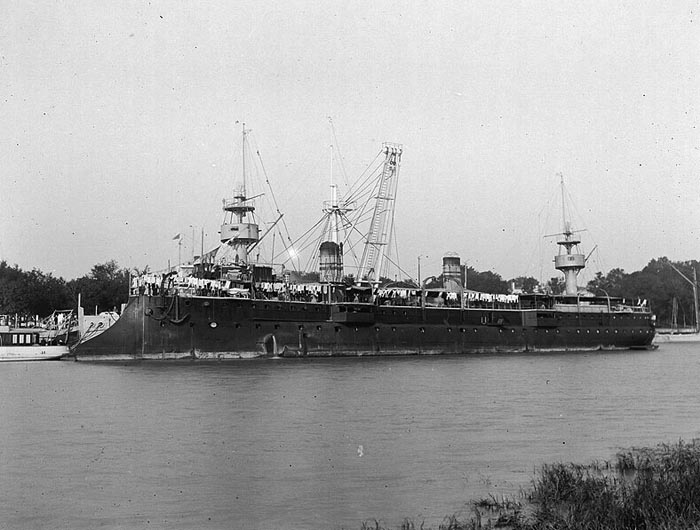
Suchet was ordered on 1 March 1887, laid down on 1 October, stopped on 10 March 1888, resumed on 17 September 1890 with her machinery installed on 26 September 1892, and launched on 10 August 1893, then completed on 20 November. She was commissioned, stated her yard sea trials on 1 January 1894 and then acceptation trials between 20 March and 24 April, showing 18.2 knots (33.7 km/h; 20.9 mph) under normal conditions, then full commission on 13 June, full acceptation only signed on 15 September. She joined like her sister the Mediterranean Squadron on 1 October, replacing Davout at the head of her unit.
In 1895, she was part of the primary battle fleet, seven ironclads, and the cruiser Tage, three Troude-class among others, in yearly manoeuvres and exercises. The Bizerte Canal connecting the Mediterranean Sea to the Bizerte late was completed in June 1895, Suchet was among the first to pass through after its opening on 4 June. After the summer fleet manoeuvres she was assigned to “Fleet C” as part of the “reds”, the hostile Italian fleet in a scenarized attack on the blues, “Fleet A” and “Fleet B”. In 1896, she became a training ship for naval cadets and received alterations. She took part in 1895 manoeuvres in the cruiser screen of the 2nd Division (6-0 July) as well as in 1897, and after a new refit, was transferred to the Levant Division, replacing the old cruiser Bugeaud sent under repairs.
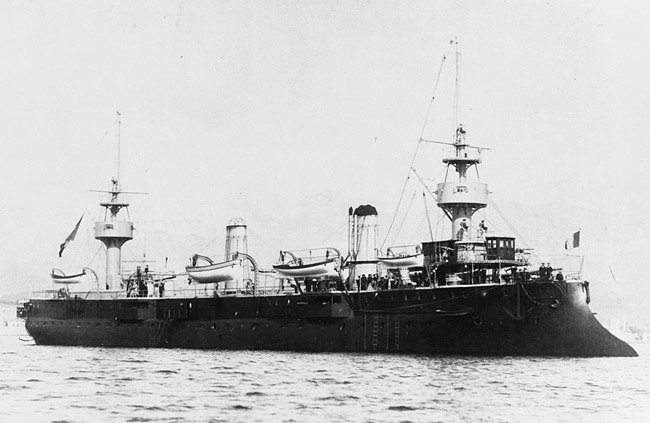
In 1900, she was transferred to the Atlantic fleet with Amiral Cécille, D’Assas, and Troude under command of Commander Pierre Ange Marie Le Bris (photo). She protected French interests in Colombia and Venezuela during domestic unrest there, and later in 1901 her squadron was reduced to just her, Amiral Cécille, and D’Estrées. By late November, she was sent to Colon, Colombia with US and British warships to try to negotiate and end the “Thousand Days’ War”. Her division was reshuffled, and she was with the cruiser Tage and Descartes.
She was among the first to respond to the eruption of Mount Pelée, Martinique in early 1902. She arrived on 6 May, two days before the main eruption which razed Saint-Pierre. She rescued 30 people, badly burned, which barely escaped. The British merchant ship SS Roraima caught fire in harbour, Suchet came alongside and try to suppress the fire but ended evacuated 35 of her crew of 68. She brought them to Fort-de-France and returned to join the evacuation over the next days, saving 1,200 people, to Fort-de-France on 11 May. She remained there for unload supplies sent from other countries and supervise distribution, restore order. Le Bris was promoted to captain for this.
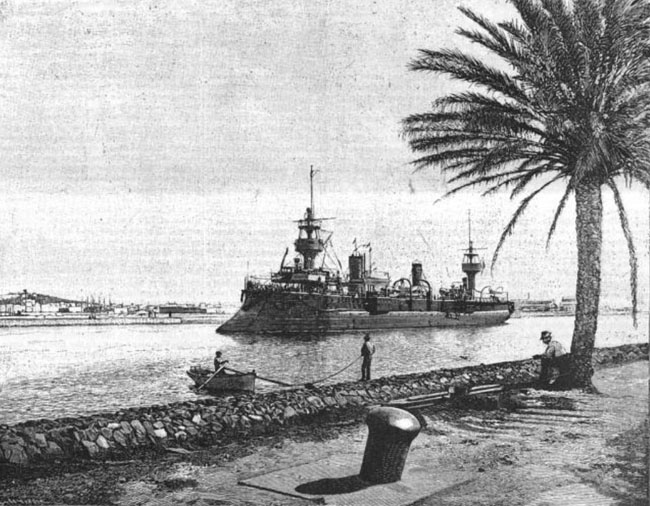
In June 1902, Suchet being still in this relief effort, the German unprotected cruiser SMS Falke met her. Both captains conferred about what was happening at Carúpano, Venezuela. The German commander informed Le Bris that Venezuelans had arrested seven French merchants over customs duties. Le Bris sailed there, asked to release them, but local authorities refused, whereas the Venezuelan gunboat Restaurador arrived and ostensively pointed her guns at the cruiser. Le Bris trained his guns in return, ordering the gunboat to come alongside, sent an officer with a landing party to reiterate his demands unless he destroys the gunboat and potentially fire in the city. This secured the release.
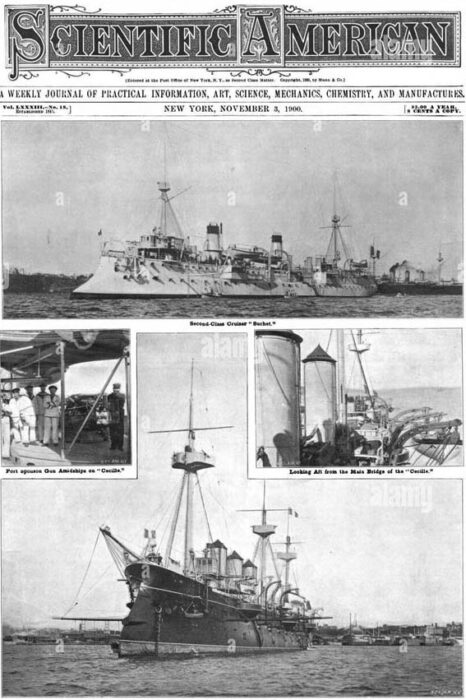
Later in 1902, Troude replaced Suchet in the division, se she returned home, but reduced to reserve on 20 November to be reboilered, a plan cancelled in 1905. She was decommissioned on 11 November. She was used as HQ ship for the 3rd torpedo boat Flotilla until struck from the register on 24 April 1906, albeit still used as HQ until 1914, then became an annex to the old floating battery Embuscade. On 28 August 1917, she was assigned to support the French merchant marine as a mooring hulk at Rochefort, until 1927. She was sold at last in November 1927 to Société Goldenberg for BU.
Read More/Src
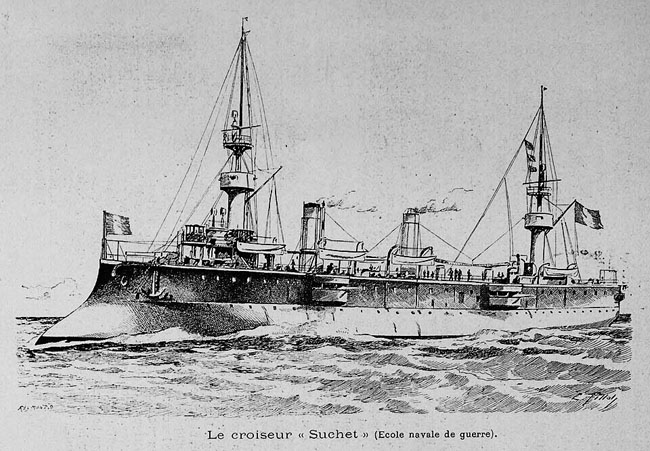
Books
Brassey, Thomas A. (1893). “Chapter IV: Relative Strength”. The Naval Annual. Portsmouth: J. Griffin & Co
Brassey, Thomas A. (1899). “Chapter III: Comparative Strength”. The Naval Annual. Portsmouth: J. Griffin & Co.
Brassey, Thomas A. (1902). “The Fleet on Foreign Stations”. The Naval Annual. Portsmouth: J. Griffin & Co.
Thursfield, J. R. (1892). Brassey, Thomas A. (ed.). “Foreign Naval Manoeuvres”. The Naval Annual. Portsmouth: J. Griffin & Co.
Thursfield, J. R. (1897). Brassey, Thomas A. (ed.). “Naval Manoeuvres in 1896”. The Naval Annual. Portsmouth: J. Griffin & Co.
Weyl, E. (1896). Brassey, Thomas A. (ed.). “Chapter IV: The French Navy”. The Naval Annual. Portsmouth: J. Griffin & Co.
Campbell, N. J. M. (1979). “France”. In Gardiner, Robert (ed.). Conway’s All the World’s Fighting Ships 1860–1905.
Clowes, W. Laird (1894). Brassey, Thomas A. (ed.). “Toulon and the French Fleet in the Mediterranean”. The Naval Annual. Portsmouth: J. Griffin & Co.
Gleig, Charles (1896). Brassey, Thomas A. (ed.). “Chapter XII: French Naval Manoeuvres”. The Naval Annual. Portsmouth: J. Griffin & Co.
Jordan, John & Caresse, Philippe (2017). French Battleships of World War One. NIP
Leyland, John (1900). Brassey, Thomas A. (ed.). “Chapter III: Comparative Strength”. The Naval Annual. Portsmouth: J. Griffin & Co.
Roberts, Stephen (2021). French Warships in the Age of Steam 1859–1914. Barnsley: Seaforth.
Ropp, Theodore (1987). Roberts, Stephen S. (ed.). The Development of a Modern Navy: French Naval Policy, 1871–1904. NIP
“Ships: France”. Journal of the American Society of Naval Engineers. III.
Links
https://www.navypedia.org/ships/france/fr_cr_suchet.htm
https://en.wikipedia.org/wiki/French_cruiser_Suchet
https://www.maritimequest.com/warship_directory/france/protected_cruisers/suchet/suchet_page_1.htm
http://dreadnoughtproject.org/French%20Warship%20Plans/
https://www.secretprojects.co.uk/threads/french-never-build-and-preliminary-designs-since-1880.41079/
Model Kits
None, want one ?

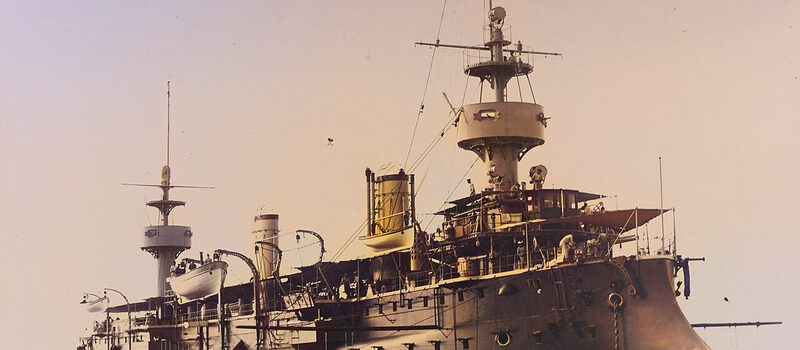
 Latest Facebook Entry -
Latest Facebook Entry -  X(Tweeter) Naval Encyclopedia's deck archive
X(Tweeter) Naval Encyclopedia's deck archive Instagram (@navalencyc)
Instagram (@navalencyc)





 French Navy
French Navy Royal Navy
Royal Navy Russian Navy
Russian Navy Armada Espanola
Armada Espanola Austrian Navy
Austrian Navy K.u.K. Kriegsmarine
K.u.K. Kriegsmarine Dansk Marine
Dansk Marine Nautiko Hellenon
Nautiko Hellenon Koninklije Marine 1870
Koninklije Marine 1870 Marinha do Brasil
Marinha do Brasil Osmanlı Donanması
Osmanlı Donanması Marina Do Peru
Marina Do Peru Marinha do Portugal
Marinha do Portugal Regia Marina 1870
Regia Marina 1870 Nihhon Kaigun 1870
Nihhon Kaigun 1870 Preußische Marine 1870
Preußische Marine 1870 Russkiy Flot 1870
Russkiy Flot 1870 Svenska marinen
Svenska marinen Søværnet
Søværnet Union Navy
Union Navy Confederate Navy
Confederate Navy Armada de Argentina
Armada de Argentina Imperial Chinese Navy
Imperial Chinese Navy Marinha do Portugal
Marinha do Portugal Mexico
Mexico Kaiserliche Marine
Kaiserliche Marine 1898 US Navy
1898 US Navy Sovietskiy Flot
Sovietskiy Flot Royal Canadian Navy
Royal Canadian Navy Royal Australian Navy
Royal Australian Navy RNZN Fleet
RNZN Fleet Chinese Navy 1937
Chinese Navy 1937 Kriegsmarine
Kriegsmarine Chilean Navy
Chilean Navy Danish Navy
Danish Navy Finnish Navy
Finnish Navy Hellenic Navy
Hellenic Navy Polish Navy
Polish Navy Romanian Navy
Romanian Navy Turkish Navy
Turkish Navy Royal Yugoslav Navy
Royal Yugoslav Navy Royal Thai Navy
Royal Thai Navy Minor Navies
Minor Navies Albania
Albania Austria
Austria Belgium
Belgium Columbia
Columbia Costa Rica
Costa Rica Cuba
Cuba Czechoslovakia
Czechoslovakia Dominican Republic
Dominican Republic Haiti
Haiti Hungary
Hungary Honduras
Honduras Estonia
Estonia Iceland
Iceland Eire
Eire Equador
Equador Iran
Iran Iraq
Iraq Latvia
Latvia Liberia
Liberia Lithuania
Lithuania Mandchukuo
Mandchukuo Morocco
Morocco Nicaragua
Nicaragua Persia
Persia San Salvador
San Salvador Sarawak
Sarawak Uruguay
Uruguay Venezuela
Venezuela Zanzibar
Zanzibar Warsaw Pact Navies
Warsaw Pact Navies Bulgaria
Bulgaria Hungary
Hungary

 Bundesmarine
Bundesmarine Dutch Navy
Dutch Navy Hellenic Navy
Hellenic Navy Marina Militare
Marina Militare Yugoslav Navy
Yugoslav Navy Chinese Navy
Chinese Navy Indian Navy
Indian Navy Indonesian Navy
Indonesian Navy JMSDF
JMSDF North Korean Navy
North Korean Navy Pakistani Navy
Pakistani Navy Philippines Navy
Philippines Navy ROKN
ROKN Rep. of Singapore Navy
Rep. of Singapore Navy Taiwanese Navy
Taiwanese Navy IDF Navy
IDF Navy Saudi Navy
Saudi Navy Royal New Zealand Navy
Royal New Zealand Navy Egyptian Navy
Egyptian Navy South African Navy
South African Navy






























 Ukrainian Navy
Ukrainian Navy dbodesign
dbodesign